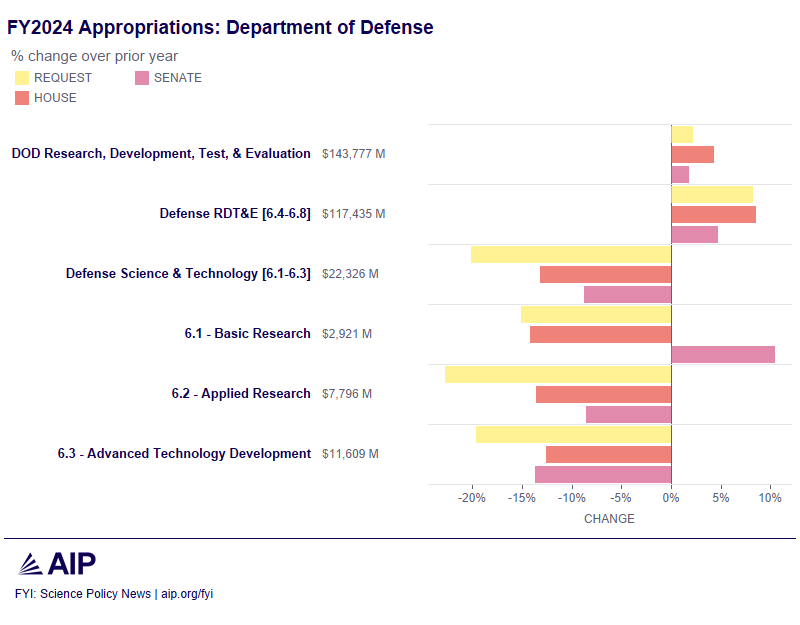FY24 Budget Outlook: Department of Defense
The limits placed on the Department of Defense budget for the coming fiscal year are less stringent than the ones on non-defense agencies. They will nevertheless check recent growth in Research, Development, Test, and Evaluation (RDT&E) spending, which at $144 billion is more than double its fiscal year 2016 level. Now, House appropriators are seeking a 4% increase and Senate appropriators a 2% increase.
Within the RDT&E topline, funding is set to plunge for DOD’s three budget categories covering early-stage R&D: Basic Research, Applied Research, and Advanced Technology Development. The Biden administration proposed a 20% cut from their current combined level of $22.3 billion, and the House and Senate proposals call for cuts of 13% and 9%, respectively. However, the Senate proposal for Basic Research bucks the general trend, aiming for a 10% increase to $3.23 billion.
The administration’s request is detailed in DOD’s budget justification documents,

Chart of budget proposals for DOD
Basic research and STEM education
Basic Research. The Senate proposal’s boost for Basic Research is unevenly distributed across the military service branches, with the Navy and Air Force accounts both in line for the largest increases, amounting to about $100 million each. Funding for DOD-wide programs would actually decline overall under the Senate proposal, from $927 million to $862 million, which is still considerably more than the $761 million the administration requested. In the current fiscal year, the Space Force is for the first time administering a Basic Research budget, which the Senate proposal would increase from $55 million to $185 million. However, both the administration and the House proposal would discontinue it.
DURIP. In recent years, Congress has provided well more funding than requested for the Defense Universities Research Instrumentation Program, which draws on the Basic Research budgets from across the service branches to provide universities with grants to acquire scientific instruments. The Senate proposes a further increase, from $163 million to $250 million, while the House proposal only adds $10 million onto the administration’s $50 million request.
Minority-serving institutions. For years, Congress has provided funding well exceeding the requested amounts for a DOD program that supports Historically Black Colleges and Universities and other minority-serving institutions. Now, the administration has significantly raised its request, seeking steady funding of $100 million. The House proposal would meet the request and the Senate proposal would provide $121 million. The Senate proposal also includes $10 million for a “Hispanic-serving research cohort” within a separate Basic Research account.

Howard University President Wayne Frederick speaks at an event on Jan. 23, 2023, marking the establishment of a DOD-funded University Affiliated Research Center at Howard focused on tactical autonomy. Behind him are Defense Secretary Lloyd Austin, center, and Air Force Secretary Frank Kendall. Howard University is the first Historically Black College or University to host a UARC.
(Eric Dietrich / U.S. Air Force)
National Defense Education Program: NDEP funding increased almost $30 million this fiscal year to $174 million but is now poised for a retreat, with the administration proposing $160 million, the Senate $162 million, and the House $139 million. Within NDEP, the administration is seeking to increase the budget for the SMART scholarship-for-service program from $104 million to $132 million to increase the number of fellowships awarded. The program awarded
MURI. The administration plans to increase funding from $211 million to $234 million for the Multidisciplinary University Research Initiative, which awards multi-year grants to university-based teams. Neither the House nor the Senate proposal directly addresses the program.
Other university initiatives. The administration seeks an increase from $41 million to $48 million for an account that funds the Laboratory University Collaboration Initiative (LUCI), which supports joint projects between DOD lab scientists and DOD-funded academics, and the Vannevar Bush Faculty Fellowship program. DOD states it is working to restore LUCI to “robust and consistent” activity and to fund international partnerships similar to those funded through MURI. DOD funded one such project
Selected innovation initiatives
Defense Innovation Unit. After Congress more than doubled DIU’s budget to $112 million in the current fiscal year, the House proposal now aims to multiply it to $1.03 billion to start building a portfolio
Mission Acceleration Centers. Congress added $50 million to the current $29 million National Security Innovation Network budget for establishing Mission Acceleration Centers, which are regional hubs for facilitating engagement between DOD, venture capital firms, and startups. NSIN established the first such center
Strategic capital. The administration requested $99 million for DOD’s new Office of Strategic Capital,
Selected technology programs and initiatives
DARPA. The Biden administration seeks to increase the budget for the Defense Advanced Research Projects Agency from $4.06 billion to $4.38 billion, but the House and Senate proposals would provide smaller increases, to $4.12 billion and $4.09 billion respectively.
Electronics Resurgence Initiative. The administration seeks to keep funding for DARPA’s ERI effort steady at $710 million, and the House and Senate proposals do not specify total amounts for it. However, whereas the administration sought $206 million within ERI for the Next Generation Microelectronics Manufacturing program, down slightly from $218 million, the House proposal would reduce its funding to $56 million, citing “execution risk,” and the Senate proposal includes $131 million, citing a desire to reduce year-to-year carryover of funds. DARPA recently selected
Other microelectronics programs. The administration initially requested an increase for its Trusted and Assured Microelectronics accounts from $897 million to $1.11 billion. However, the House and Senate proposals indicate the figure has been lowered by $100 million, and they would respectively provide $901 million and $964 million. In fiscal year 2024, DOD will also receive the second installment
Quantum devices. The administration has requested $75 million for a new account focused on near-term applications of quantum information science. Of the total, $45 million is for maturing quantum inertial sensors, gravity sensors, atomic clocks, and quantum electro-magnetic sensors and for transitioning them into acquisition programs. The remaining $30 million is for building up supply chains of components needed for quantum devices, including quantum computers. The House proposal would meet the request but transfer $40 million of the total to the Defense Innovation Unit, which it argues could leverage a broader industrial base. The Senate proposal rejects the request, citing a “lack of acquisition strategy.”
Quantum R&D at AFRL. Congress has provided funding in recent years significantly exceeding requested amounts to build up quantum R&D efforts at the Air Force Research Lab site in Rome, New York. In the current fiscal year, it provided an additional $90 million, and the House proposal would add $65 million for fiscal year 2024, while the Senate proposal would add $29 million.

Sen. Kirsten Gillibrand and (D-NY) and Senate Majority Leader Chuck Schumer (D-NY) attend a ribbon-cutting for the new Extreme Computing Facility at the Air Force Research Lab’s site in Rome, New York, on Aug. 8, 2023. The facility will house laboratories dedicated to quantum information science, networking and security, and neuromorphic computing.
Bioindustrial manufacturing. Congress provided DOD with $300 million this fiscal year to establish new biotechnology manufacturing institutes. A year ago, the administration announced plans for DOD to spend $1 billion over five years on bioindustrial manufacturing infrastructure and requested no further funding for institutes in fiscal year 2024, but the House proposal includes an additional $100 million. The budget request states that, using already-appropriated funds, the existing BioMADE Manufacturing Innovation Institute is preparing to establish a network of pilot-scale facilities to conduct R&D to “improve the ability of the industrial base to assess, validate, and scale new, innovative bioindustrial manufacturing processes for the production of chemicals, materials, and other products.” Other new facilities will address gaps in bioindustrial infrastructure and assist in transitioning laboratory-scale research results into pilot-scale production. DOD released
Mobile nuclear reactors. DOD received $168 million in the current fiscal year, or $37 million more than requested, for an ongoing effort known as Project Pele to develop mobile nuclear power supplies. Most of the funding is for a reactor prototype
Nuclear spacecraft propulsion. The administration seeks to ramp up funding from $45 million to $82 million for DARPA’s DRACO (Demonstration Rocket for Agile Cislunar Operations) project, which is developing a spacecraft propelled using nuclear fission. The Senate proposal would provide $69 million while the House proposal does not directly address the project. NASA and DARPA announced
Missile-tracking satellites. The administration proposes ramping down funding for the Next-Generation Optical Persistent Infrared (Next-Gen OPIR) missile-warning satellite constellation from $3.35 billion to $2.62 billion, and the House and Senate proposals respectively include $2.58 billion and $2.21 billion. The project’s large budget reflects a focused effort by DOD and Congress to push it rapidly through to launch. The first satellite in the constellation is scheduled for launch in 2025, though it is facing the possibility
As proposed, the full constellation comprises three geosynchronous satellites and two polar-orbiting satellites. However, DOD has already determined that in the future it should move toward a more distributed satellite architecture for missile warning and tracking that employs numerous satellites in low and medium Earth orbits to minimize vulnerability against attack. In its request, DOD proposed to cut


